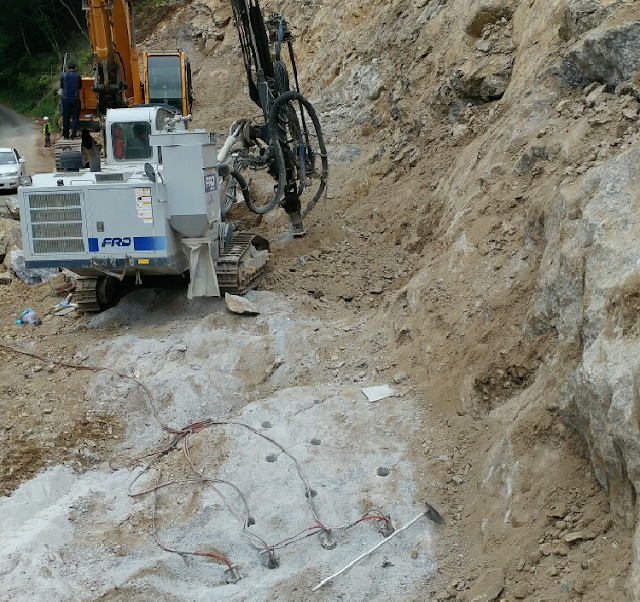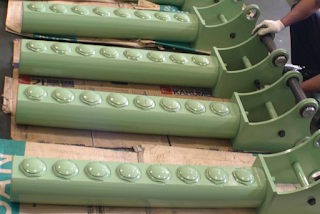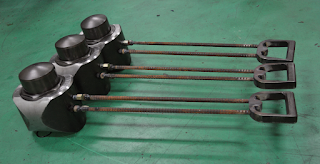An inquiry from a Quarry site :
Can we apply hydraulic splitting to replace explosives?
How many sets of hydraulic splitters are in need?
Whenever we get a question on our hydraulic rock splitting performance, we feel sorry that we are unable to reply with adequate answers. The performance of rock splitting is decided by drilling performance on the site!
If you keep only one drill rig whcih can make 50 holes per hour, you can split that number 50 holes with a set of 6 cylinders in an hour. Splitting requires pre-drilled holes always.
If you keep two drill rigs which can make holes of 100 per hour, you can split 100 holes per hour with the same set fo 6 splitters too.
If you keep 3 drill rigs which can make holes of 150 per hour, can a set of 6 cylinders split those 150 holes?. It depends on several factors.( spacing, rock strength, splitter's power). you need to study its details before you say yes, or no.
The blogger had received
above inquiry and tried to understand the quarry site situation. The inquirer sent some more information as follows:
The quarry site had been using explosives for a long time. But now they had to consider alternative rock breaking than explosives. The quarry is surrounded by rock wall of 15meter high. Every hour the quarry needs production of 100 cube meter rocks before crush.
A basic concept in drilling rock holes:
Hard rock requires more stress than soft rock. Distant spacing requires more stress than close spacing. Rock splitters have differing expanding stress from others depending on the splitter sizes. There are various kinds of rocks to break. Where can we start ?
(1)Make
"initial spacing" as 500mm . This spacing means from center of hole to next center of hole. You can adjust the distance after some experience with the rock site.
(2) Drill holes
as deep as 1,000mm or so.
With a manual type splitter, you need rock holes depth of 1000mm or over. So the rock holes need be drilled 1000mm or longer deep. With a mechanical type splitter, the length of cylinder differs variously from 300mm upto 1,300mm or so.
(3) Calculate each
cycle time of 6 cylinders as 4 minutes . A manual type set splits the 6 holes within 3~5 minutes per cycle. This cycle includes time of insertion and taking out of the cylinder to next holes. Just apply 4minutes as a cycle time.
This cycle time depends on the size of cylinders, kind of type( mechanical or manual). and the rock's characteristics . A manual type is breaking rock as deep as 700mm .
Let's assume we shall take manual type sets of splitters .
Understanding above basics, we need calculate volume of rocks per each cycle splitting.
6 x 0.5m x0.5m x0.7m = 1.05 (cube meter). / 4 minutes.( with manual type splitters)
Therefore, each hour can split the rocks of 15.75 cube meters.( = 15 x 1.05 )
Splitting 100 cube meter rock requires 6.4 times( sets) of 15.75( 100 / 15.75= 6.4) .
Some other considerations:
Assumed set of splitter is either 85 mm diameter 10 piston cylinder set or 95mm diameter 7 pistons cylinder set. When we use a mechanical type splitter, rock holes, piston cylinder diameters and length of the cylinder can be varying.
Assumed rock strength is between 50~100MPa in compressive strength. According to the differing strength of the rock the distance can be adjusted.
Assumed length of splitter is 700mm . If the length differs, the performance will vary.
Assumed strength of the power pack is 1,200 kgf/cm2. If you want to use higher hydraulic pressure, the spacing may vary too.
Assumed splitter set is manual type. If you use mechanical type cylinder, the performance can be more efficient.
For example, a mechanical type cylinder of 100mm diameter has 1000mm length.
It requires spacing of 600mm between holes. This spacing reflects the spacing for the very hard rock.
Each cycle this set produces 2.16 cube meters. Each cycle takes 5 minutes. 4 sets of mechanical type cylinders can produce 100 cube meter rocks.
6 x 0.6 x0.6 x 1.0 = 2.16 cube meter/ 5 minutes. ; one cycle .
Per hour, 12 cycles are possible. This leads to 25.92 cube meters/ hour ( = 12 x 2.16 )
In order to break 100 cube meter rocks, 4sets of mechanical type cylinders ( 6 x 100 mm diameter 10 pistons) are required.
In other case, a mechanical type cylinder of diameter 100mm, 1,500mm long can be built for more performance. It weighs around 92kgs per each. As the splitter has long cylinder, it can break more rocks at a time.
It requires basic spacing of 600mm( very hard rock), 800mm( hard rock) and 1,000mm ( medium hard rock),
and 1,200mm ( soft rock).
Assuming that the rock is very hard rock, 6 splitters can break the rocks of 38 cube meter rock per hour.
6x 0.6 x0.6 x1.5 = 3.24 cube meter / 5minutes: one cycle. 12 cycles are possible per hour.
This results in 38 cube meters volume of rock ( = 12 x 3.24 ). In order to break 100 cube meter rocks, you will need 3 sets of 6 splitters ( 100mm diameter ,1,500mm long ) .
Assuming the rock is soft type rock, 6 splitters can break rocks of 150 cube meter.
6 x 1.2 x1.2 x1.5 = 12.96 cube meter, / 5minutes; one cycle. 12 cycles are possible per hour.
12 x 12.96 = 155.52 cube meter. Only one set can break rocks of 155 cube per hour.
Above suggestion is based on very conservative position. Actual splitting time can be shorter. Spacing can be varying to a certain degree. The final performance is calculated after analyzing the rocks strength and texture or location. Usually several test breaking decides the optimal spacing.













